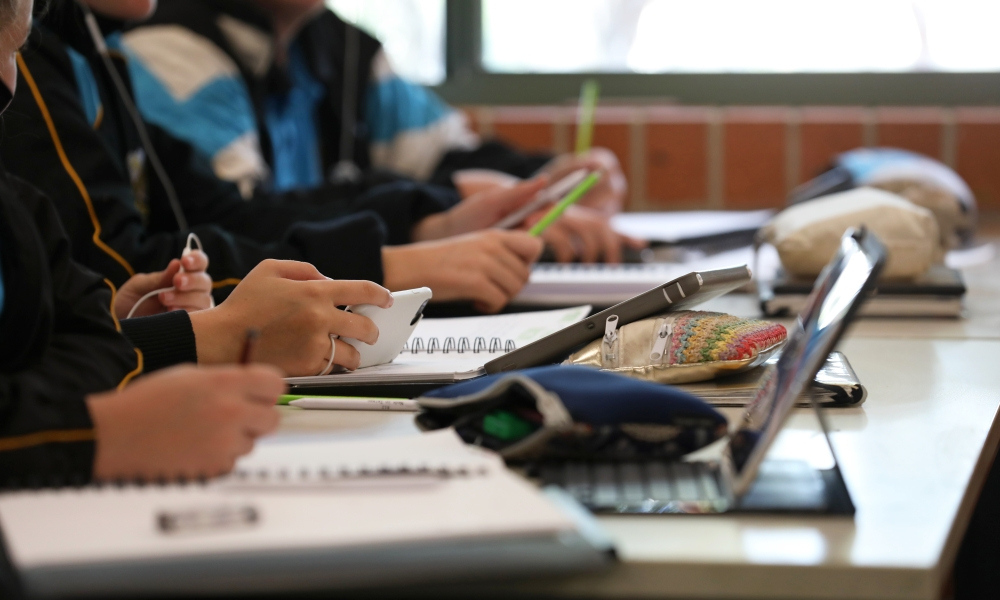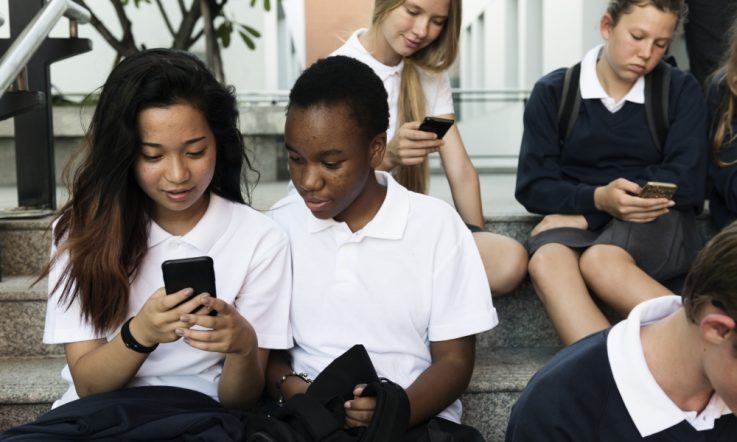The amount of time children and teenagers are spending on digital technology inside and outside school is having a significant impact on their classroom learning, and physical and mental wellbeing, according to teacher and principal data from an Australian research study.
The first round of data from Growing Up Digital Australia show 84 per cent believed devices were a growing distraction in classrooms, while 78 per cent reported students' ability to focus on educational tasks had decreased (Gonski Institute for Education, 2020). The majority of educators surveyed also reported a decrease in student empathy (78 per cent) and physical activity (60 per cent), while roughly four out of five (81 per cent) said they had seen an increase in online harassment and cyberbullying. Almost six out of 10 teachers and principals (59 per cent) reported a decline in students' overall readiness to learn over the last three to five years.
The report on Phase 1 results of the study was released this month by the Gonski Institute for Education, at the University of New South Wales in Sydney. In his foreword, the institute's Director, Professor Adrian Piccoli, says the Australian findings make for ‘sobering reading'. ‘… it is clear that the time children spend both in and out of school on digital technologies is having a significant impact not only on their brains, minds and bodies, but also how they experience the world around them,' he adds.
Who is involved in the research?
The research is being carried out in three phases. In Phase 1, in the four months from September 2019, 1876 Australian teachers and principals completed an online survey. These findings will inform the development of the Phase 2 survey, to be launched next month, which will explore parent and grandparent perspectives. In Phase 3, researchers will focus on the views of young people.
Of the Phase 1 participants: almost all (95 per cent) were from primary and secondary schools; 26 per cent were from in rural, regional and remote schools; 48 per cent were teachers and 31 per cent were principals; 74 per cent were females; the most common age group was 41-60 (60 per cent); 48 per cent had more than 20 years' experience in the profession.
Reflecting on the negatives and positives
Report authors Amy Graham and Pasi Sahlberg say: ‘Australian educators send us a clear message in this study: classrooms have become emotionally, psychologically and behaviourally more complex places for teachers to teach and for students to learn.'
When discussing the impact of digital technologies on student wellbeing, teachers commented on the pressure students face of having to ‘measure up' in the cyber world, how they struggle not to be in constant contact with their phone, and students who are obsessed with social media and gaming.
In addition to observing a decline in students' overall readiness for learning in the last three to five years, Graham and Sahlberg say many teachers report ‘declining literacy, numeracy and oral language skills, as well as reduced abilities to apply deeper, meta-cognitive skills to their learning and concentrate on tasks'.
Two out of three teachers said more children were now arriving at school tired (67 per cent), and the same proportion of teachers say they've seen a drop in the number of students who are meeting homework deadlines.
More than eight out of 10 (83 per cent) said they found it difficult to manage students' phone use in class – and even where they were banned, they found it difficult to monitor student use of other devices, such as tablets and computers. Many teachers said students were veering off task to use phones and other devices for texting, listening to music, gaming, chatting online and even contacting parents. Half of the schools in the survey had Bring Your Own Device (BYOD) policies and 95 per cent had a smartphone policy – most commonly, this was around restricting use of the devices while at school.
'Teachers believe that students living in poverty, as well as male students, have been most severely negatively impacted by the explosion of technology,' Graham and Sahlberg report. Four out of five of those surveyed agreed socioeconomic circumstances impact a student's access to technology, with one third observing children living poverty had less access than their peers.
Discussing the difference between male and female students, one teacher commented: ‘in my observations, male students to be more likely to be addicted to games, staying up late playing computer games and being tired. They tend to be the ones who cannot log out quickly when they are told to, as they feel the need to ‘finish' or complete whatever task they are doing, even when it is educational.'
Among the positives: 43 per cent of educators said they thought technology enhanced their teaching and learning activities; 68 per cent said it had enabled opportunities for inquiry-based learning; and 55 per cent said it enhanced student reporting. Six out of 10 teachers said technology has had a positive impact on the learning experience for students with disabilities, and those working in remote schools with access to technology said it had opened up opportunities for their students that they would not otherwise have had.
Even so, there were concerns from teachers that, despite spending more time on devices, many students were lacking basic computer skills and were passive users of online content.
Where to from here?
Graham and Sahlberg say it's obvious we have a problem, but argue the issue is not with the devices and content they carry, but our inability to grasp the benefits and dangers of safe and responsible use. They add that this is a complex issue with local challenges, so there can't be a one-size-fits-all solution.
‘The key response to these observed changes must be to help children adopt and learn ways of living responsible, safe and healthy lives in the digital world around them. This is not achieved by allocating blame or banning technologies (like smartphones), but by mindful education and working together on smarter sustainable solutions.
‘…Supporting children to grow up in digital world must be a shared responsibility for us all and acknowledging that we all have something to learn is the first step.'
References
Gonski Institute for Education. (2020). Growing Up Digital Australia: Phase 1 technical report. Gonski Institute for Education. UNSW.
Stay tuned: Teacher will be taking a look more of the survey results collected from educators in a forthcoming infographic.
In this study, 83 per cent of teachers said they found it difficult to manage students’ phone use in class – and even where they were banned, they found it difficult to monitor student use of other devices, such as tablets and computers. How do you monitor students’ use of devices in your classroom? Have you found any techniques to be particularly effective?
Teachers in this study commented on the positive impacts technology has on student learning. Consider the ways technology has positively impacted your classroom. Do the positives outweigh any negatives?



